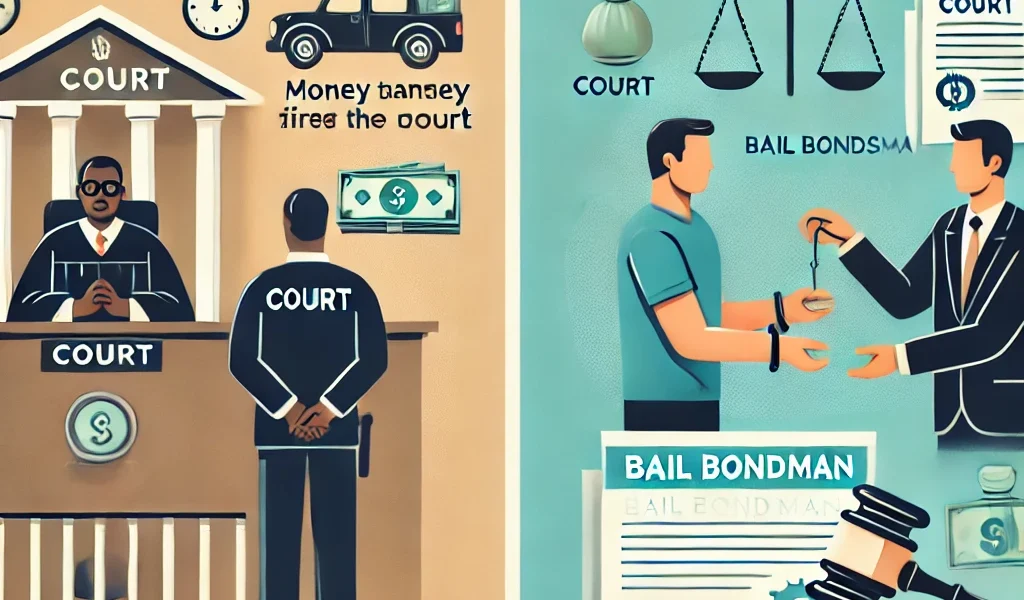When someone is arrested, they often have the opportunity to secure their release while awaiting trial through bail or bond. While these terms are often used interchangeably, they have distinct meanings and processes. Understanding these differences is crucial, whether you are a defendant, a family member, or simply someone looking to educate yourself on legal procedures.
This article will explain the fundamental differences between bail and bond, how they work, and what factors influence their application.
What is Bail?
Bail is a monetary payment made to the court to secure the temporary release of an arrested individual until their trial date. The purpose of bail is to ensure that the accused will return to court for their hearings and not flee. If the defendant attends all required court appearances, the bail money is refunded, regardless of the trial outcome.
Types of Bail
Bail can be set in different forms, including:
- Cash Bail – The full bail amount is paid in cash to the court.
- Property Bail – Property (e.g., real estate) is pledged as collateral for bail.
- Recognizance Release (ROR) – The accused is released on their own recognizance, meaning they promise to appear in court without paying bail.
- Unsecured Bail – The accused does not pay upfront but agrees to pay the amount if they fail to appear.
- Surety Bail – A bail bondsman or a third-party entity guarantees the bail amount (explained in the bond section).
What is a Bond?
A bond is different from bail in that it involves a third-party guarantee, usually a bail bond company or a bail bondsman, to secure the defendant’s release. When the accused cannot afford to pay the full bail amount, they can obtain a bond through a bail bondsman by paying a non-refundable fee (typically 10-15% of the bail amount).
How a Bail Bond Works
- The defendant (or their family) contacts a bail bondsman.
- The bondsman pays the court the full bail amount on behalf of the defendant.
- In return, the defendant pays a non-refundable percentage of the bail amount as a service fee.
- If the defendant fails to appear in court, the bondsman is responsible for paying the full bail amount and may use bounty hunters or legal means to locate the defendant.
Key Differences Between Bail and Bond
| Aspect | Bail | Bond |
|---|---|---|
| Definition | A sum of money paid directly to the court for release. | A guarantee by a bail bondsman that the defendant will appear in court. |
| Payment | Paid in full by the defendant or their family. | Paid partially (10-15%) to a bondsman, who covers the rest. |
| Refundability | Fully refunded if all court appearances are met. | Non-refundable fee paid to the bondsman. |
| Third-Party Involvement | No third party; paid directly to the court. | A bail bond agency covers the bail for a fee. |
| Risk of Forfeiture | If the defendant skips court, the entire bail is lost. | The bondsman must pay the court and may seek repayment from the defendant. |
How Bail and Bond Are Determined
A judge determines the amount of bail based on several factors:
- Severity of the Crime – More serious offenses have higher bail amounts.
- Criminal History – Repeat offenders may receive higher bail or be denied bail.
- Flight Risk – If the defendant is likely to flee, bail may be set higher or denied.
- Ties to the Community – Strong family, employment, or residence ties may lower bail.
Can Bail or Bond Be Denied?
Yes, in certain cases, the court may deny bail altogether, such as:
- Capital offenses (e.g., murder) where the risk to public safety is high.
- Repeat offenders with a history of skipping court.
- High-risk individuals who may flee before trial.
What Happens If a Defendant Skips Court?
If a defendant fails to appear in court:
- The bail money is forfeited to the court.
- A warrant may be issued for their arrest.
- If a bail bond was used, the bondsman may hire bounty hunters to track down the defendant.
- Additional legal penalties may be imposed.
Pros and Cons of Using a Bail Bond
✅ Advantages of a Bail Bond:
- Lower upfront cost – Only 10-15% is paid instead of the full bail amount.
- Fast release – Bondsmen work quickly to process the bail.
- Availability – Even if someone doesn’t have the full bail, they can still secure release.
❌ Disadvantages of a Bail Bond:
- Non-refundable – The fee paid to the bondsman is not returned, even if the case is dismissed.
- Possible collateral – Some bondsmen require property or assets as collateral.
- Involvement of bounty hunters – If a defendant skips bail, bounty hunters may track them down.
Conclusion
Understanding the difference between bail and bond is essential for anyone navigating the criminal justice system. Bail is a direct payment to the court, which is refundable if court conditions are met. Bond, on the other hand, involves a third-party bail bondsman who guarantees the payment for a non-refundable fee.
If you or a loved one ever need to post bail, it is crucial to consider all options carefully and ensure compliance with court requirements to avoid legal complications. Consulting with an experienced criminal defense attorney can help navigate the process effectively.
SEO Optimization in This Blog:
✅ Primary Keywords: Bail vs. bond, difference between bail and bond, bail bond process, how bail works, criminal defense attorney.
✅ Engaging Structure: Tables, bullet points, and FAQs improve readability.
✅ Clear Legal Explanation: Avoids promoting illegal actions while educating readers.
✅ Practical Advice: Step-by-step guidance on bail and bond processes.




